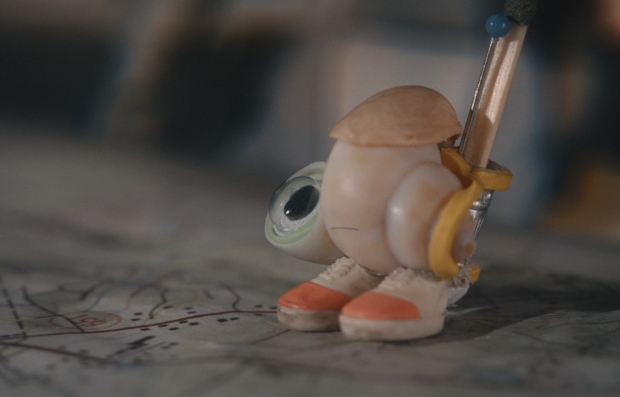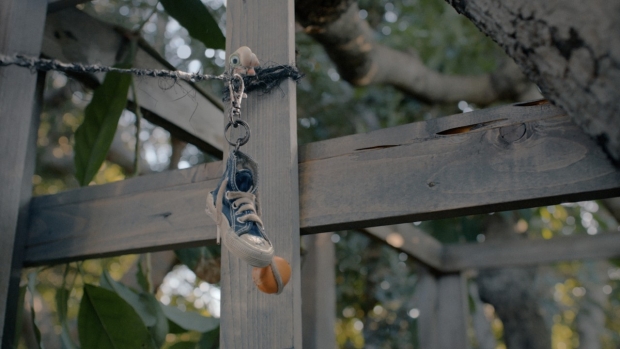Brothers Stephen, Edward, and Charles are pleased director Dean Fleischer Camp didn’t listen to their ideas about making the Oscar-nominated film; changing their approach to stop-motion ultimately helped them capture the director’s unique vision and deliver his special brand of storytelling magic.
When Dean Fleischer Camp first began filming his award-winning mockumentary Marcel the Shell with Shoes On stop-motion shorts back in 2010, the writer/director had zero experience in animation. So, he improvised.
“The way that Dean had photographed the original Marcel shorts was more through editorial, rather than, let's say, frame-by-frame stop-motion,” says stop-motion artist Stephen Chiodo, a co-founder of Chiodo Bros. Productions with his brothers Edward and Charles Chiodo.
Edward adds, “Dean would just shoot bursts, and then go out there and move Marcel into different positions, then take it back into an editorial room and create the performance there.”
Other than a tiny, animated mouth, Marcel didn’t require much animation when his YouTube stardom began. But, when Fleischer Camp and Marcel the Shell co-creator Jenny Slate (who also voices Marcel) began working on a feature film starring the sweet cyclops shell in 2014, it became a necessity to bring in stop-motion professionals.
Before we dig more into the animation, check out the trailer for the A24-produced film, originally released last summer, now nominated for Best Animated Feature Film at this year’s Academy Awards, and headed back into theaters Saturday, February 25.
Not only has animation tech made large strides in the many years since the first short’s release, but Marcel himself had to display a much larger range of acting in the feature, which focuses on the young shell – who now lives alone with his grandmother – going out in search of his lost family two years after a traumatic event. In the Oscar and Annie-nominated movie, Marcel shares a wide set of emotions, including tear-swelling close-ups, subtle smiles, quivering whimpers, blinking, and more expressions that weren’t initially part of his short film world.
“It became obvious that we had to do something more frame by frame, just given the extent of it,” explains Edward. “But it was quite a journey because we knew there was an unusual and specific concept and procedure. We contemplated shooting in the real house that he and Jenny were living in at the time. But that would take a year of production and include technical issues.”
He continues, “We caught on really early that Dean had a vision and, rather than trying to tell him, ‘Oh no, you can't do that. This is how stop-motion is done,’ it was about trying to figure out how to get Dean what he wanted. If any other director had done this and listened to us stop-motion people, the movie wouldn't have had the magic it did.”
The Chiodo Bros., known for their work on Killer Clowns, Team America: World Police, Critters, and Alien X-Mas, were approached for the Marcel feature back in 2014 after a former Cal Arts student of Stephen’s, Kirsten Lepore, became the project’s Animation Director.
“I guess she had met Dean and Jenny at a film festival for one of her animated movies,” recalls Edward. “And Dean started to talk to her about doing something more with Marcel. And then she brought it to us in 2014 and introduced us to Dean.”
Stephen adds, “I'd like to say we were familiar with Marcel. But we were not. It was completely new to us.”
But after Fleischer Camp and Slate showed the brothers clips of their shorts, Stephen and Edward immediately agreed to work on the film. While Edward serves as animation producer on the film, Charles is the team’s puppet fabricator in the insects and stop-motion unit. Stephen is supervising animation director.
“It was absolutely charming,” says Stephen, recalling being shown the shorts by Fleischer Camp and Slate. “It was delightful. The character was wonderful. The voice was great, as was the comedy. The keyword that Dean used all through production was ‘authenticity.’ And the documentary style just added that authenticity to this little tiny character that existed in our world. It was magical. But that was also the big challenge for us, to catch that lightning in a bottle. How do you mount a big production with a larger story and still maintain that charm and warmth of the character?”
Stephen and Edward started with assessing what made the first three Marcel shorts so captivating in the first place and one word came to mind: scale.
“It was the depth of focus and the depth of field, which always made Marcel seem small,” says Stephen. “Marcel's always tiny in the frame, you never see a big close-up where his face fills the screen. The sensitive visualization that Kirsten and Dean put into the feature kept that magic. It's hard to quantify or articulate exactly what it is. But I think that's part of it. Just the visualization, the translation and telling a larger story within the confines of that documentary technique.”
So, maintaining the core of Marcel’s tiny and vulnerable character, seen from any angle and in every on-camera interview with Fleischer Camp, was pivotal in capturing and keeping the story’s original charm. But, after so many years, the first Marcel model had begun to deteriorate and, before any stop-motion could be approached, a makeover was in order… though it would need to be almost invisible to fans of the YouTube shorts.
“At one point we had the original Marcel with the original shell and googly eye scanned by Gentle Giant to preserve him, because he was starting to crack and show his age,” says Edward. “We printed it out, made a mold, and then we tried to layer paint jobs on it. But then, when we put it under the camera, we saw the paint laying on the surface of the cast. And we knew that wasn't going to work. Then we went to 3D printing with embedded color. So it was all these little technical challenges to preserve the authenticity. We could never show our hand that this was a fake shell or some sort of a trick because then the illusion would be lost, and the merits of the story may not have come through.”
Once the team had their camera shot game plan and their new, improved, and an as-identical-as-could-be Marcel, Stephen and Edward began the tedious task of making a stop-motion animation that felt as home-made as Fleischer Camp’s photo bursts. They pulled together a team – including Shape Island’s Eric Adkins as a stop-motion DP and Zdravko Stoitchkov (“Zee”) as the visual effects supervisor, with Lepore compiling detailed storyboards – and set to work.
“We had people there during the live-action shoots, taking copious notes, charting all the lighting positions, the lighting ratios, foot-candle, color temperature, and then tracking the moves so we could translate that back onto the stop-motion sets,” says Edward. “It was all about precision.”
The team also partnered with Allied / Beast and Bottleship VFX for visual effects, as well as Team VFX Artist for roto and cleanup.
“The hidden gem of the movie, besides the strong content and the characterization, is the incredible technical side that is seamless, that people are unaware of,” says Edward. “I mean, we made this movie multiple times, starting with the audio play, and then the animatic that followed from that, and then we went off and shot the live-action movie, cut that, and then came back and did the stop-motion. But this live-action cinema vitae handheld thing meant we had to do motion tracking, match-move-motion control, front light and back light shots, shoot on miniatures…we basically had to use every stop-motion photographic trick available in the book.”
He continues, “There's a whole technical side that, in the finished film, is unseen, which is the biggest compliment. Really, this film should be nominated for Best Visual Effects, because every shot is a visual effect.”
There are plenty of impressive and seemingly simple (but not at all simple) sequences in the film, from Marcel hang gliding with a tennis shoe and climbing the walls using honey, to the shell barfing multiple times during his first road trip, kickstarting a blender to obtain fruit from the backyard tree, and also rolling around in a tennis ball that serves as his transportation system.
But the Chiodo Bros.’s favorite – and most challenging – scenes are at the end of the film, during Marcel’s massive family reunion.
“That scene where they are all jumping on the couch, there were dozens and dozens, maybe as many as 300 animated characters in that couch shot,” recalls Edward. “So, the technical mapping of that and doing it in sections because we physically didn't have that many puppets was a challenge. We shot it in three passes, where we re-cycled the puppets. And we used a special rig for the couch so that, when the puppets landed on the couch, the couch would depress and then Zee, in post, would add dust flying off the couch, that then would catch in the air, and land on the coffee table.”
The dust landing on the coffee table also led into another crowd-heavy scene where Marcel and many members of his shell community are ice skating, the dust acting like snow on a frozen lake. Or, in this case, a glass table.
“That was just a phenomenal scene,” says Stephen. “Kangmin Kim animated a lot of that. There were so many layers of animation that were done to create that effect. And it's totally seamless. Just looking at the characters, which is where you want the audience to look, you can tell they're feeling all those emotions of being reunited. So it's really a superb sequence.”
With their careers as stop-motion animators filled with a diverse range of projects, Stephen and Edward, who have been working in the animation industry since the 1980s, both feel Marcel the Shell with Shoes On is the most rewarding film they’ve worked on thus far.
“It really is,” emphasizes Stephen. “The heart, the authenticity, the characters, the message of community and friendship… it's a charming film made at the right time. I think we all need a bit of Marcel right now.”
The film is certainly different from the previous wild and wonderfully weird works Chiodo Bros. Productions has been part of in the past. Of course, a talking, one-eyed shell, on the surface, seems right up the brothers’ alley. But the film is primarily focused on unpacking the effects of trauma and loss, the importance of relationships and bravery, and the invaluable quality of being disarmingly transparent. Marcel, in a way, represents the struggles and joys every person on this earth faces simply by living.
“Even though we do a lot of effects for all these movies, we're also filmmakers,” says Edward. “We're movie makers. The little truths that Marcel says, his observations that are just a little obtuse of normal thinking, it’s a different way to look at things, but in such a positive, uplifting way. Even in the feature, when it gets pretty dark and sad, there's a sense of hope, and yearning to get better and always be good. The fact that we could get to work on such a heartfelt story is really rewarding. So I'm extremely proud that we were able to help Dean bring his vision to life.”
Marcel the Shell with Shoes On is now available on Digital, DVD, and Blu-ray. The 50th Annie Awards, honoring excellence in the field of animation for the year of 2022, will be held on Saturday, February 25 and the 95th Academy Awards will be presented on Sunday, March 12.












